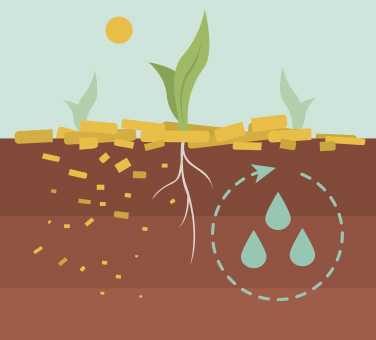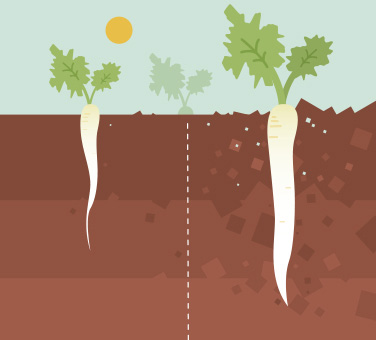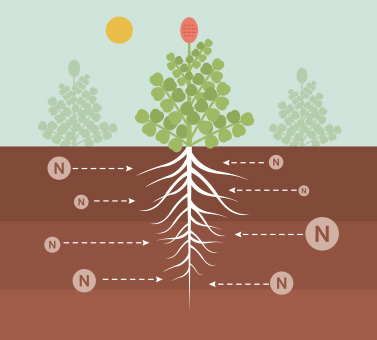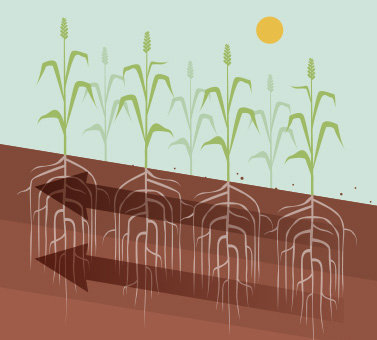Stories | November 28, 2016 | Read Time: 4 minutes
Healthy Soils for a Better Planet
Just a few inches. That’s about it. Just the top few inches of soil support the food needs of the entire planet.
What is No-Till Farming?
Farmers have always cared for the land. They understand, more than anyone, the vital importance of the health of their soil, and the role it plays in producing an abundant harvest and a better planet for all of us. Farmers take their role in maintaining soil health very seriously. Over the past few decades, soil health has been and continues to be transformed.
Rise of No-Till and Conservation Tillage
During the 1980s and 1990s, visionary farmers began experimenting with no-till and conservation tillage. These techniques leave the previous year’s crop residue on top of the soil and allow the next year’s crop to be planted directly into the remaining stubble. Farmers have continuously refined those techniques over the past 20 years, with the support of a new generation of advanced seeds, improved crop protection tools and innovative planting technology.
Over this time, according to the USDA, soil erosion on cropland has dropped by more than 40%. That means the farmer’s soil remains in place and necessary nutrients and water remain right where their crops can use them. This reduction in erosion has helped farm productivity and efficiency soar, trends that continue today.
According to the USDA, nearly one third of farmers use no-till, about another one third use reduced till, and the remaining one third use more conventional tillage practices due to the uniqueness of their local soil type and local geographical conditions.
No-till and conservation tillage are great examples of farmers adopting sustainable practices for their farms in order to better care for the land. Where it is viable, reducing tillage helps reduce soil disruption, which allows the soil to hold more organic matter and absorb more water, which is vital to the land’s productivity.
Keeping carbon in the soil is critical to fighting climate change. As crops grow, they pull carbon dioxide from the air and convert it to energy to feed the plant. Over time, part of the remaining residues — roots, leaves and stems — decompose and become soil carbon. With minimal or zero tillage, soil carbon can be an excellent form of carbon storage that prevents carbon dioxide from building up in our atmosphere.
Reducing tillage helps fight climate change.
Because more carbon is stored and not released into the atmosphere, these practices can help fight climate change. In addition, when farmers make fewer tillage passes across their fields, they use less fuel and therefore emit fewer greenhouse gasses.

Nutrients & water stay where they belong
Nutrients & water stay where they belong
Year Round Soil Protection: Cover Crops
Another rapidly growing farm practice with sustainability benefits is the use of cover crops, which are planted between primary crops to provide soil cover. Today’s modern farmers are advancing their use and finding the right combinations to enhance crop production efficiency, improve soil health and water quality, and reduce erosion.
The primary environmental benefits of cover crops are the reduction of soil erosion, increased nutrient content and organic matter, and the removal of greenhouses gases like carbon dioxide from the atmosphere.
In addition, different types of cover crops also provide different benefits for farmers. For farmers with soil compaction problems, which can make plant root growth extremely difficult, tubers like the tillage radish can provide relief, breaking up the soil while delivering improved erosion protection and increased moisture retention.

Soil compaction vs. improved soil structure
Soil compaction vs. improved soil structure
Other farmers are using nitrogen-fixing legumes like crimson clover. Natural soil bacteria, called rhizobia, pull nitrogen from the atmosphere and attach it to the legume roots. After they have decayed, the nitrogen and other nutrients become available for the following season’s primary crop.

Nitrogen scavenging
Nitrogen scavenging
And for farmers focused on reducing erosion and capturing the remaining nitrogen in the soil, cereal rye and other grasses provide superior ground cover, with fast-growing root systems that spread deep and wide to capture leftover nitrogen and keep that soil right where it belongs.

Erosion prevention
Erosion prevention
Solutions for Healthy Soils and a Better Planet
Modern agriculture is helping support farmers in their commitment to improved soil health. The prospect of using advanced data analytics to continue the soil health transformation is exciting. Farmers are using data solutions to nurture their soils and enhance productivity, all while producing net environmental benefits like carbon sequestration and reduced erosion.
With their dedication to protecting the land, today’s farmers are leading the way toward a future of efficient and productive farms built on a foundation of healthy soils.









